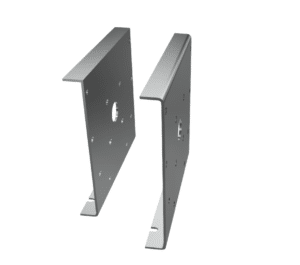There was a time, many years ago, that the presence of nescience dust in the air was considered a normal part of any bulk material handling and processing operation. In modern operations the risks associated with explosions and employee health have made the presence of even the smallest amount dust too high for any plant owner or operator to bear. As the tolerance for dust has gone down the use and refinement of point and central dust collectors has risen. There are hundreds of reputable companies making a wide range of dust collectors ranging from small point collectors to large plant-wide central dust collection systems. The focus of this article is central dust collectors and more specifically the take-away screw conveyors mounted to each. These screw conveyors are used to safely and efficiently remove expelled dust from these central dust collector systems.
Central dust collection systems are used to collect dust from many points in a bulk material handling process. The dust is filtered out in the bags or cartridges in the central dust collector. A high pressure burst of air is used to release the filtered dust from the filter elements into a collection hopper. Large dust collector systems can generate a large amount of dust that has to be disposed of. There are a couple of options to deal with this dust. The first is to expel the dust through a rotary airlock into a trash bin of some type, but for larger systems a screw conveyor is used to convey the dust to a large trash bin. Below are some points to consider when sizing or selecting a dust collector screw conveyor.
Airlock Location
The first point to consider is the location of the airlock. Since the dust collector system is operating under a vacuum, the airlock is used to isolate the vacuum from the outside atmosphere.
- Single airlock at the hopper discharge – If the airlock is located at the discharge of the dust collector hopper there are no special concerns for the dust collector screw conveyor
- Multiple airlocks at the hopper discharges- Multiple airlocks have the same considerations as a single air lock plus the combined rate of the air lock must not exceed the rate of the take away screw conveyor
- Airlock at the screw conveyor discharge – If the airlock is at the discharge of the screw conveyor, the vacuum in the dust collector screw conveyor may need to be considered since standard screw conveyors are not design to hold any vacuum or pressure. Many dust collector manufacturers account for this additional vacuum in the design of the system, but if you have a sensitive product or are concerned about the load of additional vacuum points the screw conveyor will need to be designed with to hold vacuum.
Below are some point to consider when designing a screw conveyor to contain the vacuum of a central dust collector. These recommendations apply to scenario C described above.
Shaft Seals
The shaft seals can be a major leakage point for a dust collector screw with the airlock at the discharge because the entire housing will be under a vacuum. The standard screw conveyor seal, a waste pack seal is nothing more than an oil seal and is incapable of holding vacuum or pressure. For many dust collector manufacturers this is not considered an issue and a little leakage at the screw conveyor is acceptable. This might not be the case if you are trying to the get the most efficiency out of your dust collector as possible or have a combustible product where you want to limit how much oxygen is in the system. A better shaft sealing solution is a packing gland seal with several rows of rope packing or even a split gland seal with a single row of rope packing. Both of these seals are capable of holding a small amount of vacuum.
Cover Design
Like the shaft seals the cover can be a point of leakage in vacuum. The standard screw conveyor cover has minimal thickness, bolting and gasketing. To help the cover seal better, a thicker cover (10GA Min.), tighter bolting (6″ centers), better gasketing (Closed cell rubber) and 4-sided bolting are recommended.
Trough End Design
Like the shaft seals the trough end can be a point of leakage. A standard trough end is rounded at the top and does not seal against the cover in a vacuum. A better solution is a trough end with a squared off top to allow for a tighter seal to the cover. This can be accomplished by welding the top flange of the trough end to the trough end plate, instead of forming it in a break press. The additional cost is minimal but is essential if the screw conveyor is expected to hold the dust collector vacuum. (In the trough end image, the one on the left has a welded flange for vacuum containment and the one on the right is a standard formed trough end. )
Screw Design
Most dust collector screw conveyors are full pitch. This is fine in most cases as long as the airlock is before the screw conveyor inlet. If the screw conveyor is mounted directly to the hopper with the airlock at the discharge the screw will be flood fed and need to be treated as a feeder. The frequency of how often the dust collector screw is run can affect the design. If dust is allowed to build up above the screw, additional HP will be required to overcome this head pressure. In addition, the rate of the screw conveyor may need to be matched to that of the airlock at the discharge. A typical 9″ screw conveyor at full pitch will handle about twice that of a rotary airlock. A half pitch screw will usually more closely match the capacity of the airlock.

